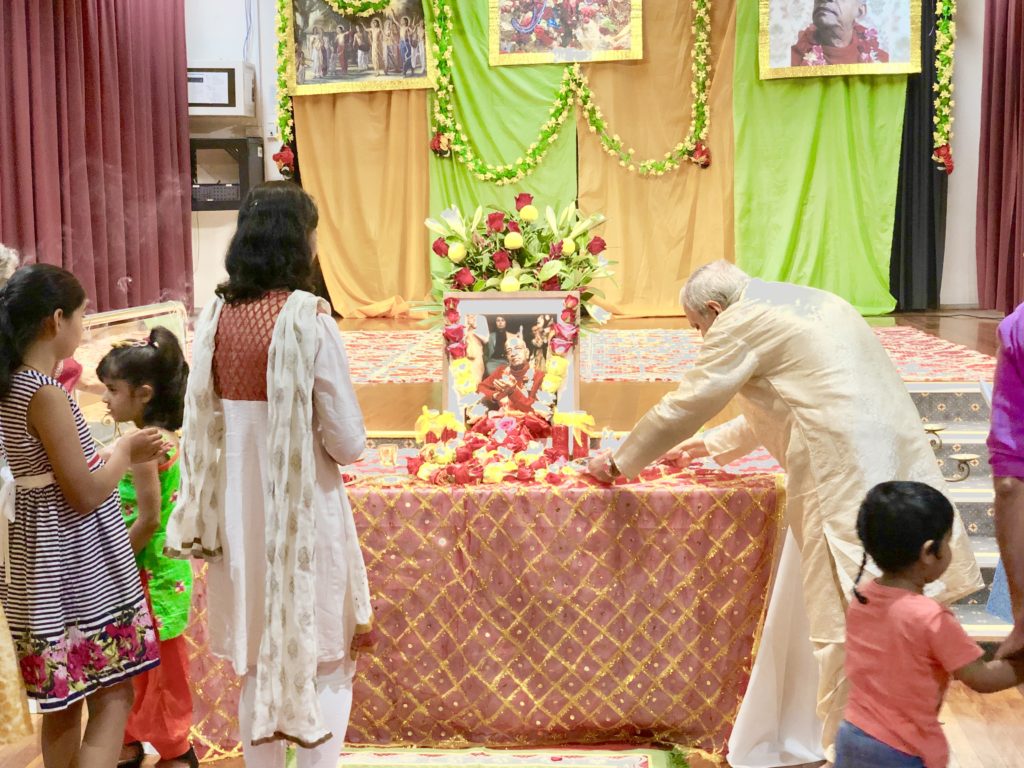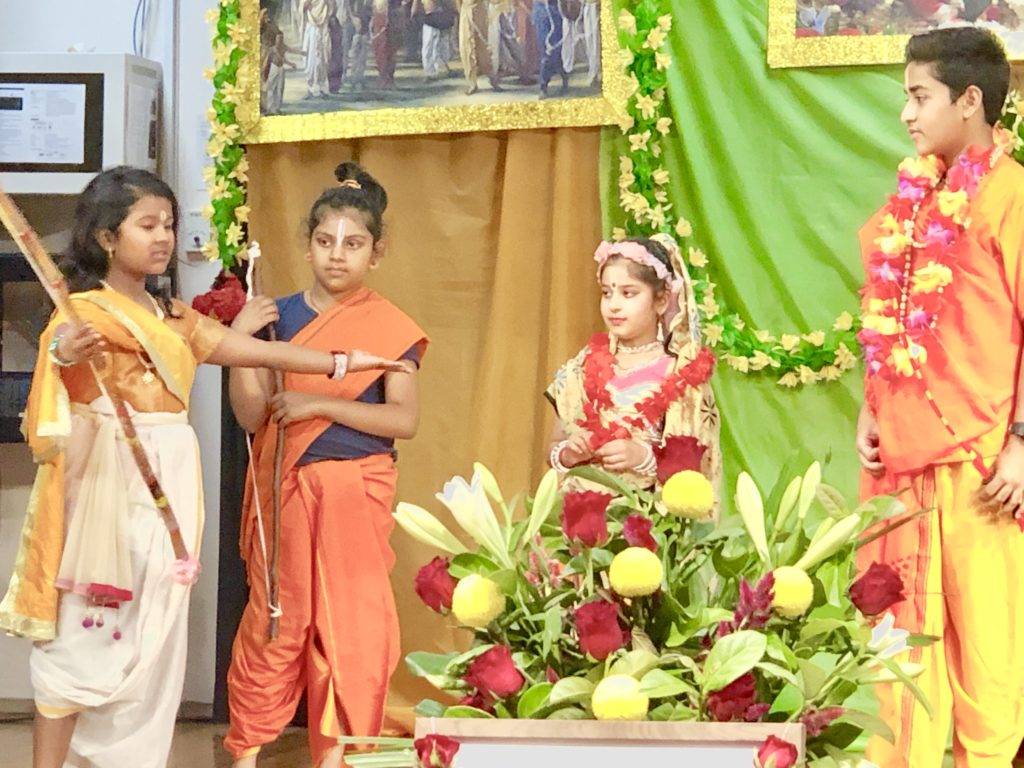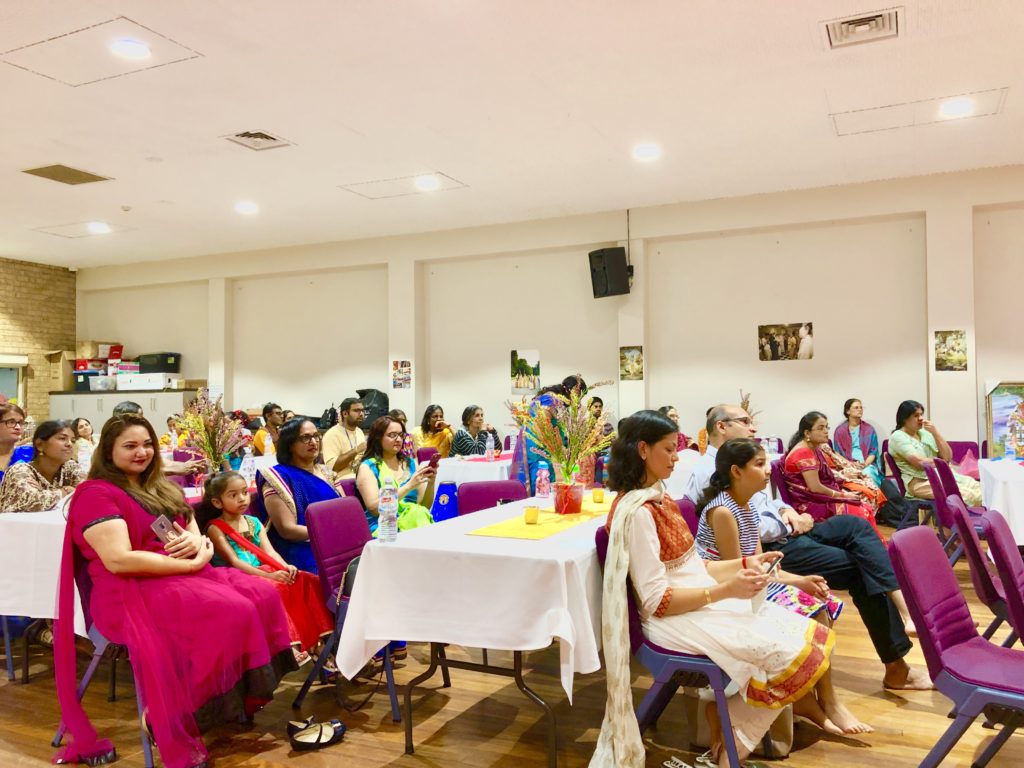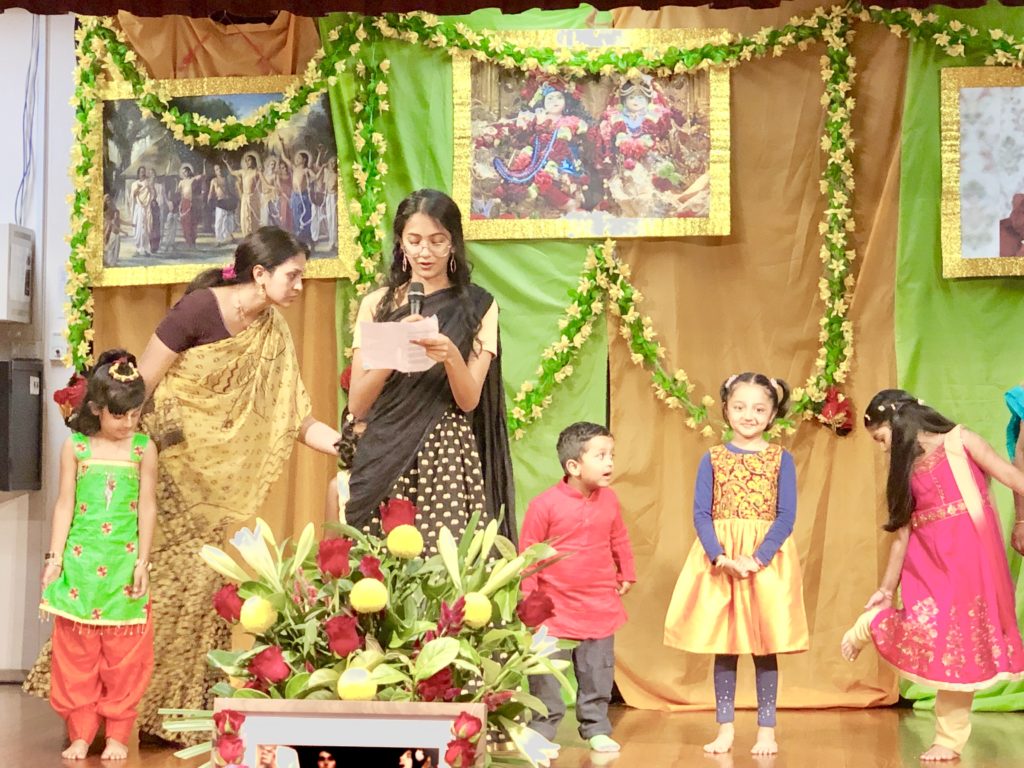
ENTHUSIASM POINTS TO GROWTH OF JALGAON WALKS
April 9, 2019
By Caitanya Jivan dasa, President ISKCON Jalgaon
Websites from the ISKCON Universe

ENTHUSIASM POINTS TO GROWTH OF JALGAON WALKS
April 9, 2019
By Caitanya Jivan dasa, President ISKCON Jalgaon

Jenni Adopts A Cow (3 min. video)
Cow protection often appeals to people who ordinarily would not become interested in Krsna Consciousness. Due to their attraction to the cow, they learn about the philosophy behind cow protection, Krishna Consciousness.
This is the story of a surprise wedding gift to a cow lover. Jenni’s parents wanted to give her a surprise wedding gift of a cow adoption. They took her on a mystery road trip and she did not know where she was going or for what purpose. Watch the video to find out what happened.
 Performing at Klyde Warren Park there was an amazing Mrdanga classical Indian dance fusion
Performing at Klyde Warren Park there was an amazing Mrdanga classical Indian dance fusion 
Sri Lakshmiji manifests in the TOVP! (Album of photos)
Sadbhuja Das: Here is the murti of the Goddess Lakshmi. This sculpture,...
 We would like to share the resources we created during this effort with the devotees worldwide, so other kids may also experience fun learning Sanskrit Alphabet.
We would like to share the resources we created during this effort with the devotees worldwide, so other kids may also experience fun learning Sanskrit Alphabet.  By Srimati Dasi
By Srimati Dasi To make everyone understand that He was accepting the sinful actions of Jagai and Madhai, Lord Caitanya’s body became blackish in complexion. The Lord inquired, “Why do you all look at Me in this manner? How do I look?” Advaita Acarya replied, “You look like Lord Krishna.” Lord Caitanya began to laugh at Advaita Acarya’s words and all the Vaisnavas became ecstatic and expressed their joy with jubilant sounds. Lord Caitanya then said, “Begin kirtana, and this black shroud of sin will lift from My body and enter the bodies of those who criticize the devotees of the Lord.” Continue reading "Beware of the Mad Elephant
→ Dandavats"
 By Hari Narayana Das
By Hari Narayana Das This year's parade was special because the show got enlivened with 40 decorative cars and boasted of participants from 37 cross-cultural communities. ISKCON community in Surabaya was also given invitation and as soon as the opportunity arrived, the devotees arranged for the Lord Jagannath's chariot festival. Devotees enjoyed spiritual bliss on pulling Lord Jagannath's chariot and the people of Surabaya in turn received the inconceivable merciful blessings of Lord Jagannath. Here is a short report. Continue reading "Jagannatha Ratha Yatra at Surabaya Vaganza
→ Dandavats"
 Giriraj Swami read and spoke from Bhagavad-gita 3.10.
Giriraj Swami read and spoke from Bhagavad-gita 3.10.
“The Lord created this material world to enable the conditioned souls to learn how to perform yajñas (sacri?ces) for the satisfaction of Visnu, so that while in the material world they can live very comfortably without anxiety, and after ?nishing the present material body they can enter into the kingdom of God. That is the whole program for the conditioned soul. By performance of yajña, the conditioned souls gradually become Krsna conscious and become godly in all respects. In the Age of Kali, the sankirtana-yajña (the chanting of the names of God) is recommended by the Vedic scriptures, and this transcendental system was introduced by Lord Caitanya for the deliverance of all men in this age. Sankirtana-yajña and Krsna consciousness go well together. Bg 3.10 purport
Darshan Room Discussion (Right-click to download)


I attended another fund raising dinner for the new temple project in Vineyard, West Sydney. The ground breaking ceremony was held the week before on the new land and although I was unable to attend, the devotees reported that it was a wonderful occasion.
The management team announced that the goal was to have the first stage constructed by Janmastami 2021 and everyone applauded. The evening went well with kirtan, speeches, drama performance by the children and prasadam at the end.



New building for the Iskcon School in Houston, Texas (Album of photos)
Goswami Academy: We are super excited to share that we ...

A Revolutionary Spirit.
Kadamba Kanana Swam: In the introduction to the Srimad Bhagavatam, Śrīla Prabhupāda quotes a very famous verse (SB 1.5.11). This is the verse that speaks about a revolution, so that attracts me because I like the revolutionary spirit, the spirit of making changes, something dynamic. Prabhupada is pointing out it is the discussion of Krsna that would bring about the change.

Mystical Vrindavan - Prahlada Kunda (Album of photos)
Indradyumna Swami: Yesterday we traveled through the countryside of Vrindavan on dusty roads to the village of Phalain, where we took darshan of Prahlada-kunda. Prahlada-kunda is said to be the home of the great devotee Prahlada Maharaja and the place where the Holika-dahan festival - a precursor to the famous festival of throwing of colors - is celebrated. Every year, during the full moon night in the month of Phalguna, the Vrajavasis celebrate the death of Hiranyakasipu’s evil sister, Holika at Prahlada- kunda. When Hiranyaksipu was unsuccessful in trying to kill his son Prahalda Maharaja, he approached Lord Siva and asked for the ultimate weapon of destruction: the fire that Siva employs to destroy the cosmic manifestation. With that benediction Hiranyakasipu built a huge funeral pyre and put his sister Holika on top of it, with Prahlad in her lap to make sure he didn’t escape. Holika had a benediction from Lord Brahma that she could never be burned by fire. When Hiranyakasipu lit the fire it burned for a long time. But in the end, Prahlada was seen blissfully chanting the holy names and Holika was burned to ashes. The acaryas say that her offense to a pure devotee, Prahlad Maharaja, nullified the benediction of Brahma. The Vrajavasis, honoring the sraddha, or deep faith of Prahlada Maharaja, burn an effigy of Holika each year to celebrate the pastime. Prahlada Maharaja lives eternally on Lord Nrsimhadeva’s Vaikuntha planet, but Krsna remembered Prahlada every year when He was present in Vrindavan by celebrating His devotee’s strong faith in divine protection at the festival at Prahlada-kunda.

Rishabh Verma: This Rama Navami, devotees must remind themselves of the promise of the Lord and with faith in his nature and words, demonstrate the principle of fearlessness in their lives by wholeheartedly engaging in devotional service. By demonstrating this principle in their lives, devotees will be able to glorify the Lord and also grant this gift of fearlessness to others who still live in a fearful state of material existence.

(Kadamba Kanana Swami, 14 March 2019, Durban, South Africa, Lotus Park Nama Hatta)
In the introduction to the Srimad Bhagavatam, Śrīla Prabhupāda quotes a very famous verse (SB 1.5.11):
tad-vāg-visargo janatāgha-viplavo
yasmin prati-ślokam abaddhavaty api
nāmāny anantasya yaśo ‘ńkitāni yat
śṛṇvanti gāyanti gṛṇanti sādhavaḥ
This is the verse that speaks about viplavo, a revolution, so that attracts me because I like the revolutionary spirit, the spirit of making changes, something dynamic. Prabhupada is pointing out it is the discussion of Krsna that would bring about the change.
It means wherever there are devotees who are chanting the names of God, that can bring about a revolution in a misdirected and misguided civilization. Where slokas of Krsna will be discussed, that is where there will be a change. And such verses are heard and sung by men who are thoroughly honest, even if imperfectly composed.
Some devotees have identified this verse as a verse which predicts Srila Prabhupada’s mission because it says that through Srimad Bhagavatam in particular the world will change. And Prabhupada brought the Bhagavatam to the western world, not the Gita. The trunks that he brought with him on the Jaladuta contained sets of Bhagavatams. He sold 1 set to the captain of the Jaladuta, and of course, later he sold other sets.
He was going to give a lecture in Pennsylvania when a man came and sat next to him and they had a discussion. It was a nice conversation and when it was time for Prabhupada to speak, he asked the man to look after his box of books. After the lecture Prabhupada asked him to open the box and hold the books up. Prabhupada explained what those books were, and then said that anyone who wanted books could go to the man and give him the money.
Prabhupada just engaged him, and in this, he put the Bhagavatam into practice by engaging someone in devotional service. It was not just a dry lecture but a real lecture. Before this person knew it he was engaged in devotional service. That was Prabhupada’s tendency – to somehow or the other engage everyone in devotional service.
The article " A Revolutionary Spirit " was published on KKSBlog.

Harinam Sankirtan in Bali, Indonesia (Album of photos)
Srila Prabhupada: The name Krishna and the Personality of Godhead Krish...

Bhaktivedanta Manor: Letting the cows out!
Our herd spent the winter months in the shelter of the barns, but the warmer weather means that it’s time to let them out.
Please join us on Sunday 21st April to watch the cows stretch their legs and feel the green grass beneath their hooves as they joyfully run onto the fields! This will be a fun occasion for all of the family
 A beautiful audio rendition of the Ramayana made professionally by Havi dasa ACBSP (Ilan Chester a celebrated Latin Grammy award Venezuelan musician, singer, songwriter and record producer)
A beautiful audio rendition of the Ramayana made professionally by Havi dasa ACBSP (Ilan Chester a celebrated Latin Grammy award Venezuelan musician, singer, songwriter and record producer) [Bhagavatam class at Hawaii, USA]
Podcast
Podcast Summary
The post Confront how bad we can be to become how good we can be appeared first on The Spiritual Scientist.
[Talk at San Jose, USA]
Podcast
Podcast Summary
Video:
The post “Do demons exist?” and lessons from Kabandha – Ramayana wisdom appeared first on The Spiritual Scientist.
[Sunday feast class at ISKCON, Sydney, Australia]
Podcast
Podcast Summary
Video:
The post Thinking about thinking – how our thoughts can harm us or help us appeared first on The Spiritual Scientist.
[Bhagavatam class on 1.11.21 at ISKCON, Sydney, Australia]
Podcast
Podcast Summary
Video:
The post How to become more personal in our dealings appeared first on The Spiritual Scientist.
[Talk at ISKCON Silicon Valley, San Jose, USA]
Podcast
Podcast Summary
Video:
The post Gita applied Chapter 2 – The Gita separates the soul from the body and harmonizes both too appeared first on The Spiritual Scientist.
[Talk at Hawaii, USA]
Podcast
Podcast Summary
Video:
The post Self-discipline or self-discovery – Charting our inner journey appeared first on The Spiritual Scientist.
[Talk at ISKCON, Hawaii, USA]
Podcast
Podcast Summary
Video:
The post How to avoid jumping to conclusions – DAS acronym appeared first on The Spiritual Scientist.
HH Giriraj Swami Bhakti-v?k?a Program Coppell, TX
Posted by Radha Kalachandji Temple in Dallas on Friday, April 5, 2019
Audio File
Srimad-Bhagavatam 2.3.17 (Right-click to download)
 On Monday 1st of April Radhanath Swami spoke to a full house on the topic of “Language of the Heart” in Bologna, Italy.
On Monday 1st of April Radhanath Swami spoke to a full house on the topic of “Language of the Heart” in Bologna, Italy.
Approximately 160 visitors from China, the Philippines, Hong Kong, and Taiwan recently came to Mayapur with His Holiness Giridhari Swami on pilgrimage. They came in two groups – the first group, of about 40 people, visited in late December of 2018, and the second group, of about 120 people, came in late January of 2019. […]
The post Visitors from East and Southeast Asia Initiated in Mayapur! appeared first on Mayapur.com.

How the soul, false ego, intelligence and mind interact with each other?
Chaitanya Charan das: The soul is spiritual. The mind, intelligence and false ego are all part of the subtle body. In general, they are differentiated, based on function rather than structure. The gross elements namely the earth, water, fire, air and ether can be differentiated in terms of structure because they are made of different things. However, the subtle elements, as described in the third canto of the Bhagavatam, in the chapter titled, ‘Fundamental principles of material nature’, are differentiated in terms of their functions. In this regard, we can take the example of a computer. In a computer system, there is a hardware, software and then the user. The hardware is a physical structure that we can perceive with our eyes. The software is an interface between the user and the hardware. The software itself can be of different types – (i) the operating system (ii) the pre-installed apps inherent to the device (iii) the user installed apps. Using this as a rough example, we can say that basic software with which the soul exists in the world, is the ego. Then there is the intermediate software which is used for accessing and functioning. Intermediate software are the pre-installed apps that come with the device. These are like intelligence. Finally, the user installed apps are like the mind.

The Lord and His incarnations (video)
Srimad Bhagavatam class by H.H. Kadamba Kanana Swami at ISKCON Vrindavan, Apr 3, 2019

We are all the eternal servants of Krishna (video)
Srimad Bhagavatam Class by Bhima Prabhu at ISKCON Juhu.
Read More...

Tolerating material miseries (video)
Srimad Bhagavatam class by HG Narayani Mataji at ISKCON Los Angeles.
Read More...

Mysteries of Sound - HH Bhanu Swami (video)
Srila Prabhupada: The process of chanting the holy name of the Lord is always superbly effective, but it is especially effective in this age of Kali. All the great authorities of bhakti-yoga recommend the devotional process beginning with the chanting of the holy name of Krishna (tan-nama-grahanadibhih). (Srimad-Bhagavatam, 6.1.21 Purport)
Read More...
 His Holiness B.B. Govinda Maharaja speaks about the importance of the TOVP
His Holiness B.B. Govinda Maharaja speaks about the importance of the TOVP This episode, I’m going solo talking about boiling the milk. The basic concept here is the importance of taking care of devotees and training them. Looking after the devotees we have rather than just going out and making new devotees. Some of the key points I talk about: 8:32 What does boiling the milk mean? […]
The post 26 – Boiling the Milk appeared first on Successful Vaisnavas - Personal Development for Hare Krishnas.
Answer Podcast
The post Is parents wanting their children to become Krishna conscious a sign of dependence, independence or interdependence? appeared first on The Spiritual Scientist.
Dhritarastra speaks these first words of the Bhagavad-gita, and while speaking this, it is significant that the first content of the Gita is dharma. As will be later revealed, the Bhagavad-gita is a book about dharma. It is primarily a question about the right course of action. The specific question that Arjuna asks is, “prichami tvam dharma samudha cetaha, I ask you about dharma because my consciousness is bewildered at this stage. Please guide me.” Prior to using this words Krishna, Arjuna has used the word dharma repeatedly in the first chapter of the Bhagavat-gita. He has talked about Kula dharma, and how that has to be protected. The word dharma will come repeatedly in Gita, and if we consider the Gita as a part of the Mahabharat, then the Mahabharat is also a search for Dharma. It is trying to explain what is dharma and how one can know what is dharma. In the Mahabharat, even the demons did not want to openly violate dharma at least initially, because they know that dharma has power, and they want to use that power for their own purposes.
Let’s look at some of the meanings of the word dharma which will be relevant over here for us. One meaning could be that: we normally translate dharma as religion which is actually an over-simplification of the point of distortion. That is because the word religion has acquired certain connotations in terms of certain rules given by someone, but that’s not all that this is about. The Bhagavatam uses the word dharma, and there are multiple understandings to it. But definitely it is not the understanding that it is just some religion that some people are following. At a fundamental level dharma comes from the root “dhri”, which means to sustain. So, “dharma” is that which “sustains” or “maintains, or that which enables things to be what they are, and ensures that things stay in their position. This would imply that when we discuss dharma – If at all it can be translated, we could call it as a “sacred law” or the “innate order” of things. So, dhrama is the innate order of things within the universe which human beings are meant to harmonize with, and also it is the innate order in the universe which society and government has to harmonize with through its laws and customs. It is also the innate harmony of our own beings by which we can be who we are or who we are meant to be. Thus, we can be who we essentially are. Such harmony is what we are all seeking in this world, and we need to try our best to achieve it, because ultimately – many people for example, nowadays, in the age of individualism, say, “Be who you are. Don’t try to imitate others, don’t force yourselves to become like something else. Don’t become a xerox copy of someone else.” Sometimes such individualism can become obnoxious and Narcism, and it can become self-obsessive, self-destructive and socially destructive. But that is not what we are talking about. The Bhagavad-gita is a work of poetry. As the very name suggests, it is addressed as Gita or song, and as a song it has its poetic features. So, among its many poetic features, is the feature of it having significant ways of stating things. The fact that the first word used in the Bhagavad-gita is dharma is very significant about what its content is going to be. Of course, dharma is a part of the compound dharma-ksetra. In that sense, it is referring specifically to Dhritarastra’s concerned whether this war which is happening on the dharma-ksetra, Kuruksetra, will affect the dharmic party (the Pandavas) positively, and if it will affect his side negatively. But beyond such concerns which are contextual, lets herein focus on the universal theme of the Gita, and that universal theme is that everyone of us needs to harmonize with our essential core. And that subject of harmony with ourselves, the world, the nature of reality, and with the ultimate reality are the essential issues that the Bhagavad-gita deals with. And we too need to deal with these essential issues. And the best way to engage with such issues is by letting our engagement be stimulated and guided by the Bhagavad-gita’s engagement with these issues.
When we want to explore a subject, there is no need to reinvent the wheel and start everything from the scratch. There are many in the past who have probed the questions that we have probed, and by connecting with them excessively, we can learn so much. And the Bhagavad-gita is not just any random ancient thought. It is a thought of the supreme person. And thus, it has profound significance. As the Bhagavad-gita will unfold, we will see how it takes us through the nuance understandings of dharma, to the supreme understanding of dharma, and then ultimately to the loving harmony with our eternal Lord.
*********************
The post Gita 01.01 The Gita’s first word dharma conveys its essential, universal theme appeared first on The Spiritual Scientist.

TOVP: 5-meter base relief panels for the 4 corner walls of the temple room (Album of photos)
Sadbhuja Das: Please, take a look...